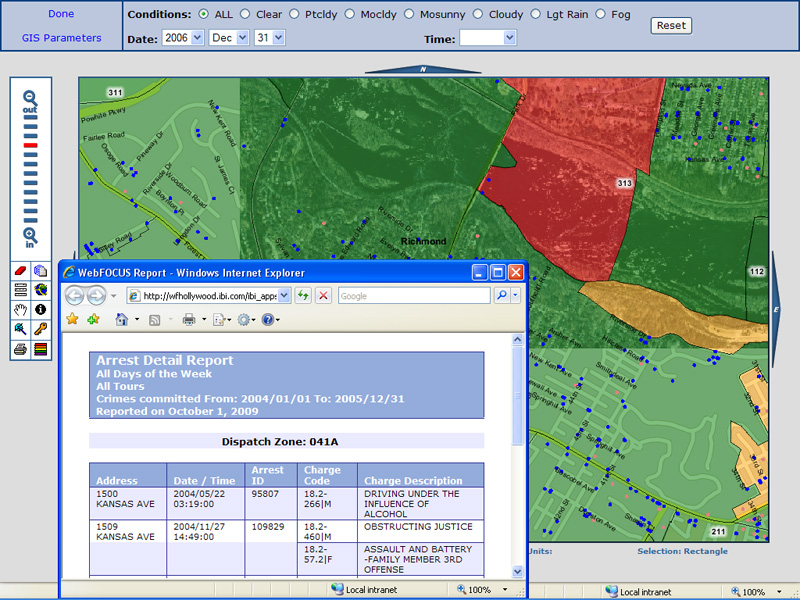
How BI is Becoming Crime’s Biggest Enemy
If this last decade is any proof, business intelligence is being harnessed for a wide array of purposes that extend beyond indentifying enterprise or customer trends. Some organizations are using BI for everything from tracking internal progress to…well, fighting crime. However, a vast majority of smaller agencies remain in the dark about how best to make use of all the information they’ve been hoarding.
 According to Rob Mills from Information Builders, many law enforcement agencies are facing the problem of being “data rich but information poor.” He argues that these organizations have a great deal of potentially golden data that sits idle in silos because no one has solved the problem of how to integrate and harness it.
According to Rob Mills from Information Builders, many law enforcement agencies are facing the problem of being “data rich but information poor.” He argues that these organizations have a great deal of potentially golden data that sits idle in silos because no one has solved the problem of how to integrate and harness it.
Some agencies set an early stage for using business intelligence to understand and prevent crime using data, including Richmond, Virginia’s law enforcement organization. As early as 2004, the agency worked closely with SPSS Inc. to take advantage of predictive analytics with Information Builders’ business intelligence software. Using the analytics backbone created by RTI International, the city used business intelligence, new (for the time) data mining techniques and expert integration tactics to arrive at a solution that benefitted everyone from the 911 operators to the officers on the duty.
While other smaller law enforcement agencies, including that in Erlanger, Kentucky (which bit off a big piece of BI for such a small city) have been using predictive modeling, data mining and general BI tools for some time, state-wide efforts are always worth examining.
Most recently, the Maryland Department of Public Safety and Correctional Services is stepping up to show law enforcement how data is done with their announcement this week about a BI-drivn partnership with Oracle. The agency is working with the state’s crime control office to streamline the way the agencies dually access real-time data related to crime activity. Further, the corrections division is tasked with a multitude of other challenges when it comes to sharing this information with a host of other agencies that rely on their data.
Maryland is harnessing Oracle’s Business Intelligence Enterprise Edition and the company’s SOA to create a unique type of BI solution. The goal of the Oracle buy is to allow the state to do a better of job of making use of real-time crime data to prevent future problems, identify trends and provide streamlined access to crime data to other agencies. What the corrections agency needed was a “one stop shop” for multiple agencies to view crime and related data in an easy to use dashboard.
The challenges of stringing together a “big BI” solution in this case are not small. The public safety and corrections division operates a total of 27 corrections facilities and 45 parole and probation supervision offices. In addition to managing crime and public safety information across these facilities, the agency needed to be able to integrated siloed systems containing information for other crime-related aspects of operations, including the sex offender registry and the division that handles gun control.
The result of Oracle’s enterprise BI solution and SOA implementation is called the “Law Enforcement Dashboard” which the state says draws from “more than 100 data sources across 22 agencies to access accurate, timely information that helps [users] make fast, well-informed decisions in the fight against violent crime.” They say that with the new system, one simple search will instantly allow users to access a person’s offender status, criminal history, photos, warrant details, gun and license information and so on—all in a single view.
This implementation caught attention at Oracle’s OpenWorld where the agency won the Oracle Fusion Middleware Innovation Award for their BI and enterprise performance management category. With this new project in place and functioning, the state is now looking to other ways to put Oracle’s offerings in practice for the state’s needs. For instance, the state’s education department will be delivering similar “dashboards” to the state’s 66,000 teachers, 6,000 administrators and over 800,000 students and parents to help schools make use of real-time information as it pertains to educational quality.
According to Kristin Mahoney who directs the state’s Office of Crime Control and Prevention within the public safety and corrections agency, “Before the Law Enforcement Dashboard, individual users had separate user names and passwords per database, putting the burden on the user to seek out relevant data. The Oracle systems turns this paradigm upside down by establishing a customer-centric solution.” Mahoney goes on to note that this implementation enhanced the agency’s “data value by making information accessible and establishing a sustainable infrastructure and process for boundless information sharing.”

(Above: Companies like Information Builders use location intelligence and business intelligence tools and dashboards to help law enforcement understand crime trends.)
While there is no doubt that the mega-agencies within the federal government are ahead of even the enterprise curve when it comes to tracking and data management within BI frameworks, more cities are looking to BI to manage and integrate an increasing number of tasks that are data-dependent.
Related Stories
BI Giants Zoom in on Location Intelligence
Jaspersoft Brings Hadoop to BI with IBM






























